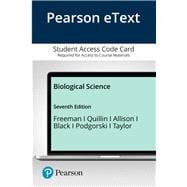Known for its discovery-based, student-centered approach, Biological Science emphasizes higher-order thinking, skill development and active learning. The text equips you with strategies that move you away from memorization to guide you in making connections between core concepts and content. You'll learn to apply your knowledge throughout the course, assess your level of understanding and identify the types of cognitive skills that need improvement.
The 7th Edition weaves one case study throughout the entire text, showing biology concepts are connected and helping you make connections across biology. New content includes updated coverage of advances in genomic editing, global climate change and insights into the evolution of land plants.
Pearson eText is an easy-to-use digital textbook. The mobile app lets you keep on learning no matter where your day takes you, even offline. You can also add highlights, bookmarks and notes in your Pearson eText to study how you like.
NOTE: This ISBN is for the Pearson eText access card. Pearson eText is a fully digital delivery of Pearson content. Before purchasing, check that you have the correct ISBN. To register for and use Pearson eText, you may also need a course invite link, which your instructor will provide. Follow the instructions provided on the access card to learn more.











